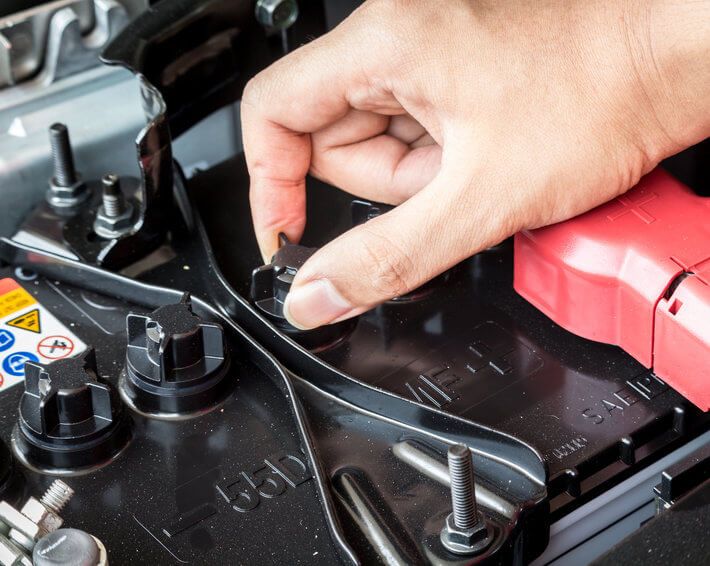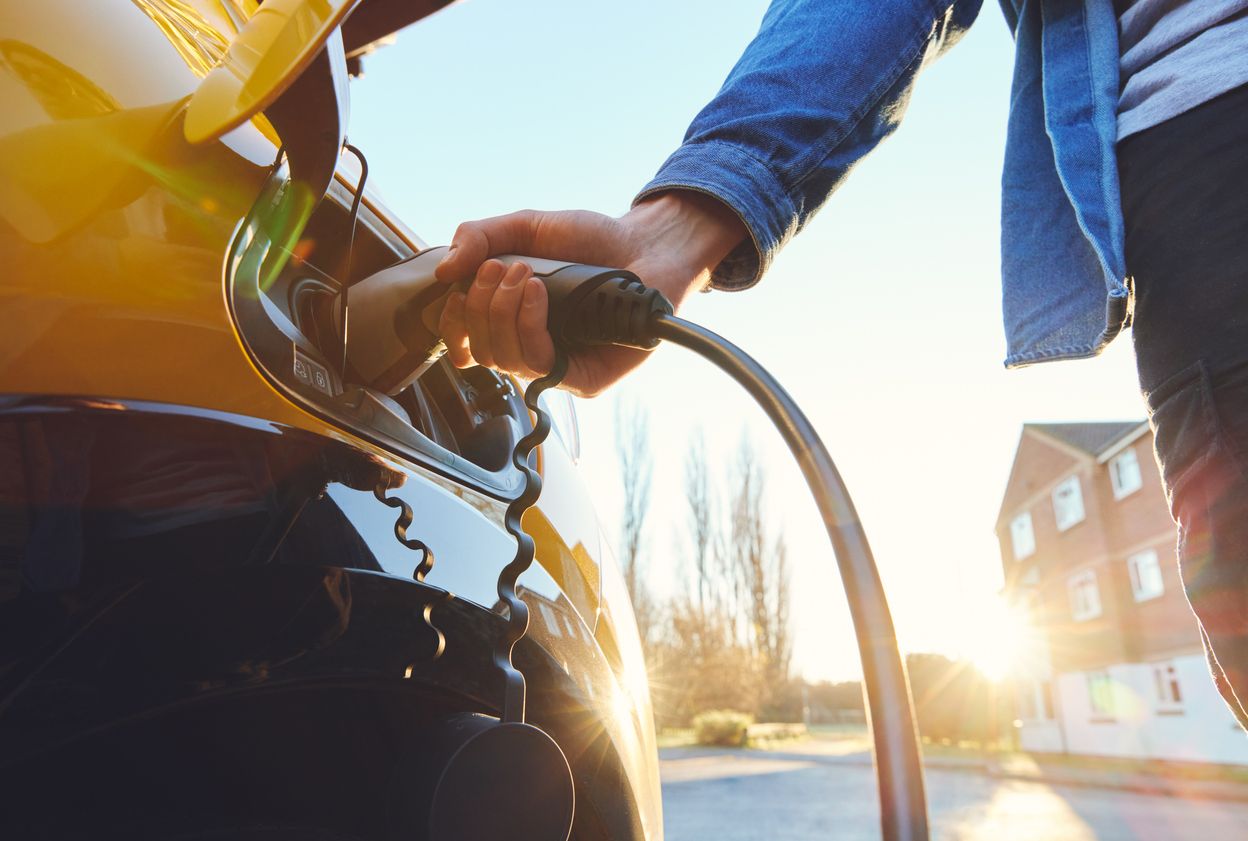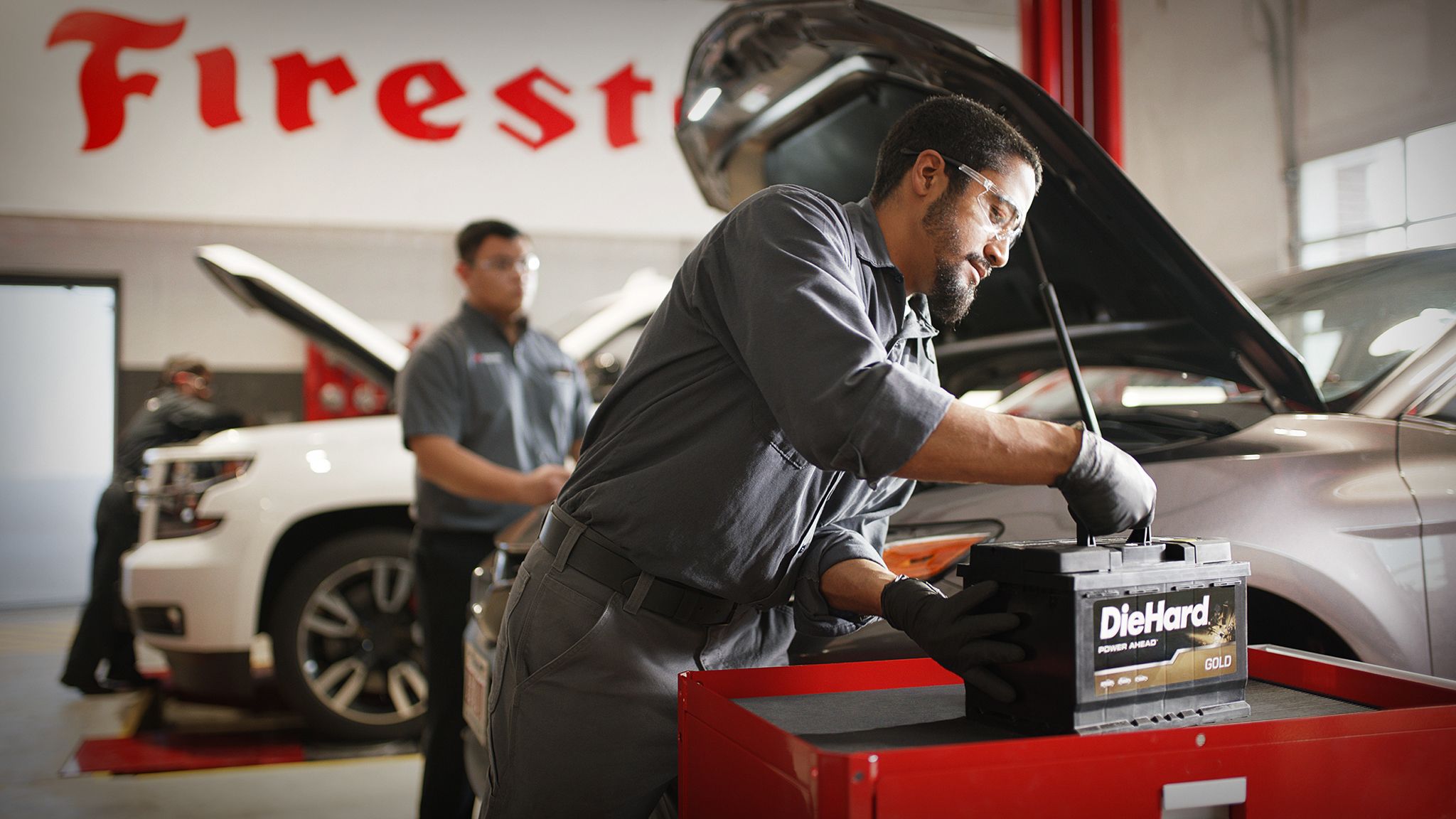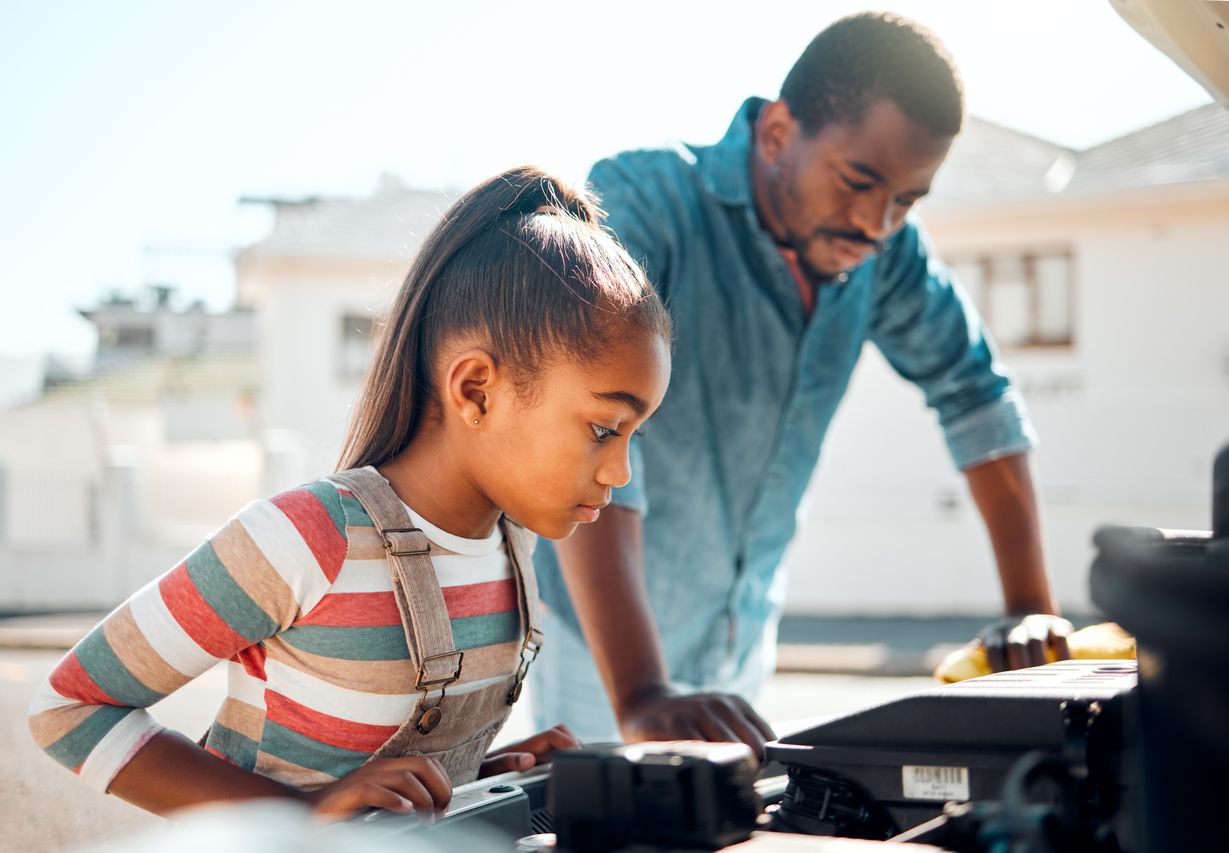Charging a dead car battery is a bit more complex — and potentially more dangerous — than charging your smartphone. You don't want to get shocked or accidentally touch battery acid. You also don't want to get stuck with a dead battery (again) if you don't let the battery charge long enough. Follow along to learn two ways to charge a car battery safely and how long to let your car battery charge.
What Does a Car Battery Do?
Before we charge ahead, you should know that a battery does two seriously important things — it gives your car the power it needs to start, and it shares the electrical load with your vehicle’s alternator.
We’ve covered how car batteries work before, so we’ll just give you the basics here. Through a series of contained chemical reactions, your vehicle’s battery converts chemical energy to electrical energy and stores it for later use. This electrical energy is then distributed as necessary.
When your engine is off, the battery may power accessories like your radio, headlights, and any onboard computers. When you turn the key to start your car, electricity is diverted to your engine’s starter, which starts your engine.
And that’s pretty much where the responsibilities of your battery end! Once your engine is started, the alternator converts the mechanical energy of your engine back into electrical energy. This steady stream of voltage keeps your engine and accessories running and recharges your battery at the same time. In the event of a faulty alternator, your car battery will take back over and keep your vehicle running for a short time.
Why Would You Need to Charge Your Battery?
When a battery is too weak or old, it may not be able to start your car or help keep it running. So, if your engine is slow to start, makes a clicking sound when cranking, or won’t start at all, it’s likely because of a dead battery.
Beyond starting your car, how your battery reacts to charging can also indicate whether it's time for a new one. For example, leaving an interior light on overnight will drain your battery, but if the battery is healthy, it should recharge quickly. A battery that needs to be replaced, however, may not hold a charge, or it might need to be recharged more frequently.
What to Do Before Charging a Battery
So, your battery is dead or needs a charge. Before you try to charge or jumpstart a car battery, follow these four steps:
1. Refer to Your Car Owner's Manual
Every car is different, and your manufacturer might have specific instructions for your make and model. So, refer to your owner’s manual for any specific charging or jumpstarting instructions.
2. Be Safe
Make sure you're charging the battery in an area where there aren't any flames, sparks, or smoke. Then, take off any jewelry, as it can be a safety hazard. You should also equip yourself with gloves and safety glasses.
3. Sniff Around
Do you smell something that reminds you of rotten eggs? If so, do not attempt to charge the battery! As the Texas Department of Insurance notes, batteries can emit highly flammable hydrogen gas. This gas can ignite from even the smallest of sparks, including those caused by disconnecting or reconnecting battery cables.
Stay away from the car, get it towed, and let a professional take a look.
4. Check for Heat
Heat rising from the battery case might mean it's been working harder than it should. Keep the hood up and let the battery cool before trying to charge it.
5. Look for Corrosion
Generally, corrosion looks like a green or white, crusty substance around your battery posts. This corrosion is often a product of battery acid fumes coming into contact with air and metal — and it’s pretty common in most lead-acid batteries. But no matter how common, it can compromise your car's electrical system and make it harder for the battery to receive a charge. You can remove the corrosion by cleaning it with a brush and a paste-like mixture of water and baking soda.
Pro Tip: If you skip this step, you may find that your car won’t start, even with a new battery installed!
How to Charge a Car Battery Without a Charger
If you don't have access to a charger, you'll need to know how to charge a car battery with another car. As stated in Step 1, check your owner’s manual first. Typically, the steps for completing this task are as follows:
What you’ll need:
- A running vehicle
- Jumper cables
- Your car owner’s manual, our handy guide to properly jumpstarting your car, or the steps below.
Once you have those items on hand, follow the steps below to jumpstart your car!
1. Get the Two Vehicles Ready
You'll need assistance from another vehicle (one with a good battery) if you're going to jumpstart your car. Locate the battery on each — they’re often found in the engine bay, but may also be under a seat or in the trunk of the car. Then, park the running vehicle so that the two batteries are as close to each other as possible. Finally, make sure that both car engines and their accessories are off.
2. Begin with the Positive Jumper Cables.
It’s time to grab those jumper cables! Connect the positive cable, which is typically red, to the positive terminal on the dead battery. This terminal is often marked with a “+” symbol. Then attach the other positive cable to the good battery. Ensure that throughout this process, you don’t bump the positive clamp to the negative terminal (or any other clamps). Otherwise, you may cause a short circuit.
Pro Tip: To prevent accidentally shorting out your ride, read our guide on disconnecting and reconnecting car batteries!
3. Connect the Negative Jumper Cables
Attach the negative clamp, which is typically black, to the negative post of the good battery. This post is often marked with a “-” symbol. Next, connect the clamp at the other end of the negative cable to an unpainted area of the chassis or engine block of the car with the dead battery.
Why not on the negative battery terminal, you ask? The second cable nearly always sparks once connected, and as we mentioned previously, the battery could emit flammable hydrogen gas. Even this small connectivity spark could lead to a fire or explosion. So wherever you put the second clamp, it should be as far from the battery as possible.
4. Start the Engines
Now, start the engine of the vehicle with the good battery. Then, try to start the car with the dead battery. If it is hesitant to start, rev the engine of the running car to increase its electrical output — this should give the dead battery the extra juice it needs. Once the car with the bad battery is started, let the two vehicles idle for a couple of minutes.
5. Remove the Cables
Once the jump-started vehicle is running smoothly, it's time to remove the cables. Start with the negative ones first, and then the positive ones — the opposite of what you did when you began the process. Here’s the order you should follow:
- Disconnect the negative (black) clamp from the vehicle with the bad battery.
- Disconnect the negative (black) clamp from the vehicle with the good battery.
- Disconnect the positive (red) clamp from the vehicle with the good battery
- .Disconnect the positive (red) clamp from the vehicle with the bad battery.
If you’ve followed these steps properly (and your battery isn’t completely irreparable), the bad battery should have enough power to allow you to drive to your nearest Firestone Complete Auto Care for a free battery check.
How to Charge a Car Battery with a Charger
If you don’t have access to jumper cables or another vehicle to help you charge your battery, you’ll need to make use of a battery charger. There’s a whole world of battery chargers out there — from big to small and affordable to expensive. Their features vary — some have an option to jumpstart your car if you need to get somewhere in a hurry, while trickle chargers only allow you to recharge the battery at a slow rate. So make sure to obtain a charger that suits your needs!
Once you have a charger on hand, it’s as easy as 1, 2, 3:
1. Connect the Charger to the Battery
This process is similar to the one for jumpstarting a battery. First, make sure the charger is unplugged and your vehicle is off. Then, attach the positive (+) clamp to the positive post on your battery.
Now attach the negative (-) clamp to a stable area on the vehicle's body, or chassis. Though you could also attach the black clamp to the battery's negative terminal, it's not the safest thing to do. As mentioned, the battery could be leaking hydrogen or oxygen gas, which could ignite from the spark of connecting the cable to the negative terminal.
2. Turn on the Charger and Let Your Battery Charge
After the charger is connected, plug it in and turn it on. Then, you'll need to adjust its amperage. Lower amps will result in a longer charging period, but it may also lead to a more reliable charge. If speed is what you're looking for, turn the amperage up — but beware, charging your battery rapidly can be bad for its longevity. Just know that the “200 amp” or “jumpstart” setting is not for charging, it is for jumpstarting; leaving the charger on this setting can ruin your battery!
Ultimately, we recommend following the directions that come with the charger and your vehicle’s owner's manual. If you find any discrepancy between the two, your owner’s manual is the one to adhere to.
Once you’ve set up your charger, let your battery charge! Depending on the type of charger you have, it may stop automatically once the battery's full, or you might have to turn it off manually. Keep reading to learn how long to charge your car battery.
3. Disconnect the Charger
After the battery has regained its car-starting powers, turn off and unplug the charger from its power source. Then, detach the clamps from your battery! Just like for jumpstarting, this should be done in reverse order — the negative (black) clamp should be the first one removed, followed by the positive (red) clamp.
How Long to Charge a Car Battery
Fully charging a battery with a charger could take anywhere from a couple of hours to a couple of days, depending on the amperage of the charger and the battery's voltage. Though a partially charged car battery may still allow you to drive your car, at least for a short distance, you run the risk of starting this process all over again if you don't wait for a full charge.
If you choose to charge your battery with another vehicle, don't turn the engine off right after the jumpstart. Instead, cruise around for at least 15 minutes so the alternator can continue charging the battery. Kill the engine too soon, and you could find yourself needing another jumpstart.
Unfortunately, if your battery is bad, it won't hold a charge — no matter how long you leave it hooked up to another car or charger. To ensure you can get help again if the battery won’t hold its charge, make sure you're at a safe location when you turn the engine off.
Car Battery Won’t Hold a Charge? Firestone Complete Auto Care Can Help.
If your car battery doesn't hold a charge, you'll need to tow your car to a place that can fix the issue. It's time for a new car battery. Fortunately, with more than 1,700 locations across the country, your nearest Firestone Complete Auto Care isn't hard to find! Stop by, and one of our trained technicians can inspect your battery and help you find the right car battery for your ride. Schedule an appointment today to give your ride the jolt it needs to get back on the road!



